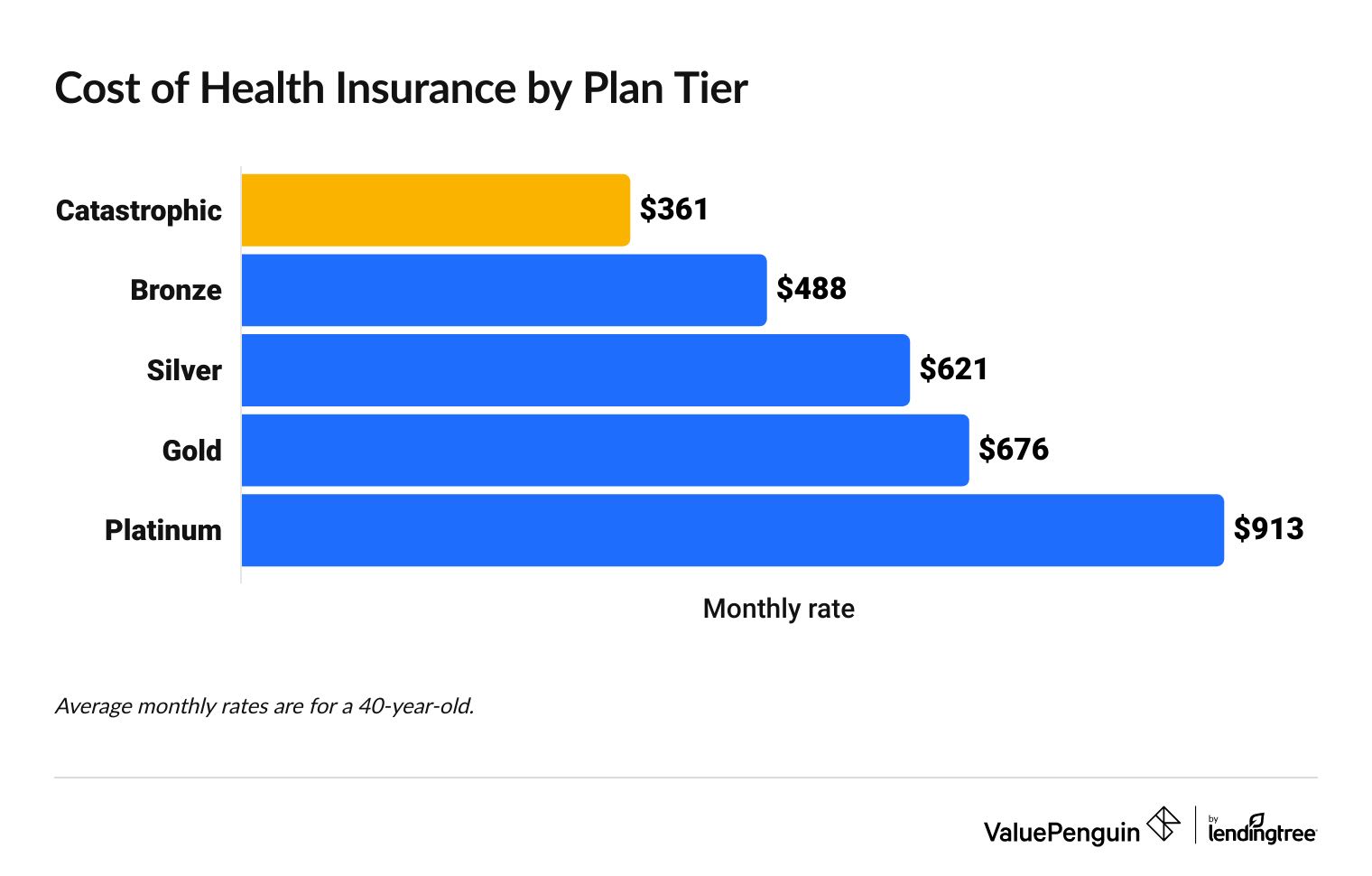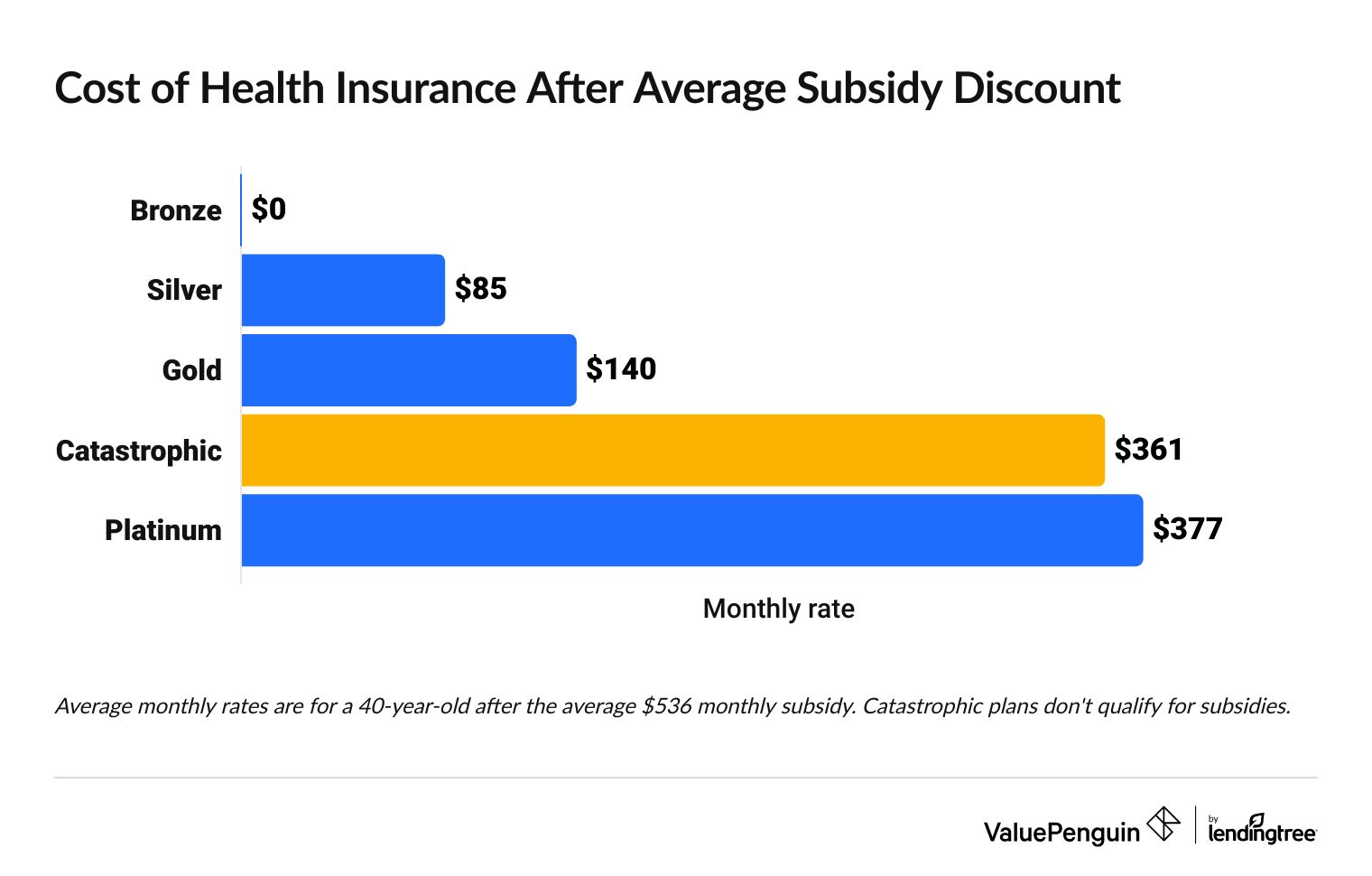Is Catastrophic Health Insurance Right for You?
Catastrophic health insurance is a type of cheap plan that covers you if you get very sick or badly injured.
If you have a Catastrophic plan, you have to pay the first $10,600 of your medical care in 2026. Catastrophic plans are sometimes called emergency medical insurance because they are generally only going to pay for your health care during expensive emergencies.
Catastrophic plans usually aren't a good idea. Many people can get health insurance discounts that can help them get a plan with better coverage for even cheaper than a Catastrophic plan.
Find Cheap Health Insurance in Your Area
On this page
What is Catastrophic health insurance?
Catastrophic health insurance is designed to protect you from very high medical bills if you get seriously ill or hurt.
A Catastrophic plan requires you to pay for the first $10,600 of your medical bills yourself. If you need surgery, have an unexpected illness or have a medical emergency, a Catastrophic plan can save you from having too much medical debt. This is why Catastrophic plans are often called "emergency medical insurance."
You'll only have coverage for a few basic doctor visits before your spending reaches the $10,600 cap. But after you reach the cap, you won't have to pay anything for covered medical care or doctor visits.
Should you get Catastrophic health insurance?
Consider a Catastrophic plan if you:
-
Are young and generally healthy
-
Want protection if you get very sick or badly injured
-
Have a tight budget and savings to pay for medical care
-
You can't get health insurance discounts, called subsidies
Don't get a Catastrophic plan if you:
-
Go to the doctor often or take prescription medications
-
Don't have the savings to pay for most of your medical care yourself
-
Can get health insurance discounts that will make a better plan cheaper
-
Don't meet eligibility criteria because you're over 30 or you don't qualify for an exemption
Who qualifies for a Catastrophic plan?
You can buy a Catastrophic health insurance plan if you:
- Are under age 30
-
Qualify for a hardship exemption, such as if you:
- Don't qualify for marketplace discounts
- Were evicted
- Filed for bankruptcy
- Have substantial medical debt
- Could not find affordable health insurance
- Had difficulty getting other health plans
- Had home damage from a natural disaster
- Experienced domestic violence
- Had a death in your family
- Received a shutoff notice for your utilities
- Were homeless
More people will be able to get Catastrophic plans in 2026. To combat rising health insurance rates, the Centers for Medicare & Medicaid Services (CMS) is working to make Catastrophic plans more available.
In 2026, you can get a Catastrophic plan if you can't get marketplace discounts, called subsidies, because you make too much. This likely means you'll be able to get a Catastrophic plan if you're single and make $62,600 per year, or more, even if you don't meet the other qualifications.
You'll also be able to get a Catastrophic plan if you make more than $39,125 per year and can't get a type of discount called cost-sharing reductions (CSRs). These are discounts you can only get with a Silver plan and that makes the cost of your medical care lower. However, even if you can't get CSRs, you can still get discounts on your monthly rate, if you make less than $62,600 per year. If you choose a Catastrophic plan, you'll lose those rate discounts because they don't apply to Catastrophic-tier coverage.
If you qualify for a hardship exception because of your finances, check to see if you can getlow-income health insurance through Medicaid. Medicaid is usually free or very cheap each month, and the coverage is much better than a Catastrophic plan. If you're single, you usually have to make less than $21,597 per year to get Medicaid.
How much does Catastrophic health insurance cost?
Catastrophic health insurance costs an average of $361 per month in 2025.

That means the average cost of health insurance for a Catastrophic plan is a quarter less than a Bronze plan, saving you about $127 per month.
Cost of health insurance by tier if you pay full price
Tier | Average monthly rate |
|---|---|
| Catastrophic | $361 |
| Bronze | $488 |
| Silver | $621 |
| Gold | $676 |
| Platinum | $913 |
Average monthly rates are for 2025 plans.
Find Cheap Health Insurance in Your Area
When is a Catastrophic plan not the cheapest option?
A Catastrophic plan won't be the cheapest option if you're one of the many people who qualify for health insurance subsidies.
Subsidies lower the cost of insurance if you meet the income requirements.
But these subsidies cannot be used for Catastrophic health insurance plans — only for Bronze, Silver, Gold and Platinum plans.
Shoppers who qualify for subsidies get an average discount of $536 per month on health insurance. This could make a Bronze plan free and a Silver plan cost just $85 per month.

A subsidy calculator can help you find out how much you'll pay for insurance based on how much you earn. Households with lower incomes will save more on insurance than those who earn more.
Average cost of health insurance after subsidies
Tier | Average monthly rate after discounts |
|---|---|
| Bronze | $0 |
| Silver | $85 |
| Gold | $140 |
| Catastrophic | $361 |
| Platinum | $377 |
Average rate in 2025 after the typical $536 monthly subsidy is applied. Catastrophic plans don't qualify for subsidies.
What does Catastrophic insurance cover?
Catastrophic plans must cover free preventative care and at least three doctor visits per year.
You'll also get free check-ups or screenings. Even though your plan pays for these services before you hit your deductible, you might still have to pay a copay in the doctor's office. For example, you might have to pay $20 when you go to your doctor for an illness.
However, you usually won't have much other coverage until you meet the $9,200 deductible. For example, you'd pay the full price if you need to see a specialist or if your doctor orders blood work at your appointment.
It's possible to have a Catastrophic plan and never reach the deductible. That means you'll have to pay for nearly all of your medical care yourself. Catastrophic plans aren't designed to help you pay for the bulk of your medical care. Instead, they're going to keep you from having tens of thousands of dollars or more in medical debt if serious medical needs arise.
After you spend $10,600, the Catastrophic plan will cover the same essential medical benefits as other health plans under the Affordable Care Act (ACA). That includes:
- Emergency care
- Hospitalization
- Pregnancy
- Prescriptions
- Mental health
- Pediatric care
Catastrophic plans and health savings accounts (HSAs)
Starting in 2026, you can open a health savings account (HSA) if you get a Catastrophic plan.
An HSA is a special type of account that lets you save pre-tax money and use it for medical bills. Remember that Catastrophic plans require you to pay a high amount toward your bills, so an HSA could be a great tool to help you save that amount.
The recent reconciliation bill treats Catastrophic plans as high-deductible health plans (HDHPs), which is the feature that allows you to get an HSA.
What does a Catastrophic plan not cover?
With a Catastrophic health insurance plan, you won't have coverage for most medical care until you meet the plan's high deductible of $10,600.
So with a Catastrophic plan, you may have to pay very high costs before the plan starts covering your medical bills. You could also have a situation where you're paying for health insurance coverage without ever getting the benefits of the plan because you didn't meet the deductible.
Can I buy short-term catastrophic health insurance?
Most short-term health insurance plans provide catastrophic-style coverage.
Short-term plans are a different type of plan that typically has high deductibles. This means the benefits won't kick in unless you have a major illness or injury. A short-term catastrophic plan can be a good way to get quick, temporary coverage if you're between jobs or waiting for another health insurance policy to begin. However, short-term plans don't have to follow the rules of the ACA, and they aren't technically the same as Catastrophic plans.
Short-term plans are different from regular Catastrophic plans:
- Short-term plans usually won't give you free preventive care or affordable check-ups before you meet the deductible.
- Plan benefits can vary widely, making it important to check your coverage carefully. For example, some plans may not cover prescriptions, mental health or preexisting conditions, even after you meet the deductible.
- Short-term plans may not be available in 14 states and Washington, D.C., because of state regulations or companies not offering plans.
If you need temporary catastrophic insurance, you may also be able to use a regular health insurance plan and keep it for a short period of time.
- Enrolling: You can sign up for a regular health insurance plan any time of the year if you're eligible for special enrollment. This includes situations such as losing other health insurance coverage or a change in your family size.
- Canceling: You can keep the insurance plan for as long as you need it and cancel without a penalty.
- Coverage: Plans are available in any tier of coverage, including Catastrophic. You can also use subsidies for other levels of coverage.
- Timing: Benefits usually start on the first of the month after you enroll and end on the last of the month after you cancel. That's different from a short-term policy, which can start the day after you sign up.
Can I buy Medicare catastrophic coverage?
Medicare catastrophic coverage is a kind of extra coverage you get with a Medicare prescription drug policy.
Catastrophic coverage is automatically included in each Medicare prescription plan as a way to protect you from very high costs if you need expensive or brand-name drugs. After you spend $2,100 on prescriptions in 2026, you won't have to pay anything for your prescriptions for the rest of the year.
How to buy Catastrophic health insurance
You can buy Catastrophic health insurance directly from an insurance company or through the government's health insurance exchange, which could be HealthCare.gov or a state marketplace, depending on where you live.
A plan you buy on the exchange will automatically follow ACA guidelines, so you know you'll have free preventive care and the standard Catastrophic cap for the year. Plans you buy directly from an insurance company aren't any cheaper.
- If you're under 30, you can enroll in a Catastrophic health insurance plan using your age to show you're eligible.
- If you're over 30, you'll have to complete an exemption form before signing up. This will give you an exemption certificate number (ECN) that you'll use with your health insurance application.
Best Catastrophic health insurance companies
Blue Cross Blue Shield has the best Catastrophic health insurance plans because of its high ratings, widespread availability, variety of plans and flexibility about which doctors you can use.
Blue Cross Blue Shield: Best Catastrophic health insurance
-
Good ratings on both HealthCare.gov and from ValuePenguin editors
-
Catastrophic plans available in 20 states
-
Offers Catastrophic PPOs and EPOs, which provide coverage for out-of-network doctors
-
Customer service depends on where you live.
Kaiser Permanente: Best customer satisfaction
-
Very high customer satisfaction and one of the best health insurance companies
-
Often provides coverage for extra medical services before you reach the plan deductible
-
Catastrophic plans only available in two states
-
You'll be covered only at Kaiser's medical facilities, unless it's an emergency
Medica: Good company that's expanding
Oscar: Cheap Catastrophic insurance
-
Often cheaper than other companies
-
Catastrophic plans available in 13 states
-
Plans are often poorly rated
-
Most of Oscar's perks, including free virtual care and $3 prescriptions, don't apply to its Catastrophic plans
In some cases, you could have just one or two insurance companies offering Catastrophic health insurance in your state. These could be local insurance companies that don't operate broadly across the country.
Learn more about the best health insurance in your state:
Frequently asked questions
What does Catastrophic mean in health insurance?
Catastrophic plans are the lowest level of health insurance available from HealthCare.gov and state marketplaces. Sometimes called "emergency health insurance," Catastrophic plans are designed to primarily cover major or emergency situations and to prevent you from having to pay more than $9,200 toward your medical bills each year.
Is Catastrophic insurance worth it?
Catastrophic insurance isn't usually a good idea. You have to pay for a large amount of your medical bills yourself, and many people will never reach the $10,600 threshold where coverage starts. However, a Catastrophic plan might be a good idea if you only need it for a short while and want better coverage than a short-term plan gives you.
How much is Catastrophic health insurance a month?
Catastrophic health insurance costs $361 per month, on average, in 2025. But your cost depends on where you live, the company you pick and your age. And remember that Catastrophic plans aren't eligible for monthly discounts, called subsidies. If you can get subsidies, a Bronze or Silver plan could be cheaper than a Catastrophic plan and give you better coverage.
Sources and methodology
Health insurance rates for 2025 are based on public use files (PUFs) on the Centers for Medicare & Medicaid Services (CMS) government website and state-run marketplaces. Average costs are based on a 40-year-old. The $10,600 Catastrophic deductible and $2,100 Part D cap are for 2026.
Additional sources include HealthCare.gov and Kaiser Family Foundation (KFF).
Insurance Writer
Cate Deventer is a ValuePenguin writer who specializes in health insurance, Medicare, auto and home insurance. She's been a licensed insurance agent since 2011.
She started her insurance career working as a customer service agent for State Farm. She later moved to an independent agency, where she worked with several insurance companies and hundreds of clients. She quoted policies, filed claims and answered insurance questions. In 2021, she pivoted her career and began writing about insurance for Bankrate. She moved to ValuePenguin in 2023 and began writing about health insurance and Medicare.
Cate has a passion for helping readers choose insurance to fit their needs. She enjoys knowing that her research and knowledge help people choose insurance products that make a positive difference in their lives.
How insurance helped Cate
Cate used her health insurance knowledge to navigate a surgery in 2023. Understanding how her policy worked let her focus on recovery instead of worrying about bills.
Expertise
- Health insurance
- Medicare & Medicaid
- Auto insurance
- Home insurance
- Life insurance
Credentials
- Licensed Life, Accident & Health Insurance Agent
- Licensed Property & Casualty Insurance Agent
Referenced by
- CBS
- NBC
- Wall Street Journal
Education
- BA, Theatre, Purdue University
- BA, English, Indiana University
Editorial note: The content of this article is based on the author's opinions and recommendations alone. It has not been previewed, commissioned or otherwise endorsed by any of our network partners.




